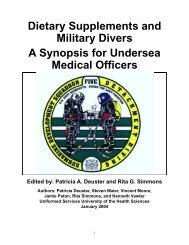Force Health Protection: Nutrition and Exercise Resource Manual
Force Health Protection: Nutrition and Exercise Resource Manual
Force Health Protection: Nutrition and Exercise Resource Manual
You also want an ePaper? Increase the reach of your titles
YUMPU automatically turns print PDFs into web optimized ePapers that Google loves.
Training Design <strong>and</strong><br />
Progression<br />
Now you are ready to design your aerobic workout! When designing a<br />
cardiovascular routine there are a few questions you must answer. These are:<br />
Questions<br />
1. What are your goals? Are you interested in health, general fitness, or<br />
performance benefits? Get more specific as you<br />
become more involved with your workout.<br />
2. What do you enjoy? Do you prefer team or solitary activities? List at<br />
least three activities that you enjoy doing.<br />
3. What are your time limits? Be realistic about the time you can devote to these<br />
activities.<br />
4. What gear do you need? Plan to get the gear you need to participate in<br />
these activities.<br />
You want to tailor your program to realistically meet your goals <strong>and</strong> time<br />
dem<strong>and</strong>s, so answer the questions honestly. (See Chapter 17 for more<br />
information on setting goals.) If you have been sedentary, begin by increasing<br />
your physical activity by performing more daily activities, found in Level 1<br />
of the Physical Activity Pyramid (Figure 4-2). Once you can easily perform<br />
these activities, add 5-10 minutes of Level 2 activities two to four days per<br />
week. Gradually increase the duration of the Level 2 activities by 10% per<br />
week until you can perform 20 to 60 minutes continuously. Your training<br />
intensity during these exercise sessions should be between 65% <strong>and</strong> 70% of<br />
your max HR (see Worksheet 5-1).<br />
If you can already perform 30+ minutes of Level 2 activities <strong>and</strong> wish to<br />
maintain or increase your aerobic capacity, exercise between 65% <strong>and</strong> 80%<br />
max HR for 30 to 60 minutes three to four days per week. If you are<br />
interested in performance fitness benefits <strong>and</strong> are in excellent aerobic<br />
condition, consider adding 15-30 minutes of high-intensity (80% to 90% max<br />
HR) activities per week in addition to your aerobic training. This will<br />
increase your anaerobic energy system <strong>and</strong> increase your ability to sprint <strong>and</strong><br />
recover more rapidly during sports such as basketball <strong>and</strong> soccer. For sport<br />
specific performance, some of your training sessions should mimic movements<br />
you perform during the sport.<br />
The golden rules of training progression are:<br />
◆ Increase only one FITT component, i.e., frequency, intensity,<br />
time, or type, at a time.<br />
◆ Increase your training by no more than 10% per week. Allow<br />
yourself time to adjust to this new routine before you increase<br />
your workout again. Increasing too fast will lead to injury <strong>and</strong><br />
overtraining (see Chapter 13).<br />
<strong>Nutrition</strong> <strong>and</strong> <strong>Exercise</strong> <strong>Resource</strong> <strong>Manual</strong> 43




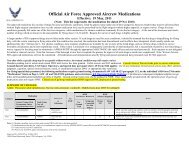

![Body Composition and Military [PDF] - Human Performance ...](https://img.yumpu.com/43269347/1/190x245/body-composition-and-military-pdf-human-performance-.jpg?quality=85)
![Tips for Grocery Shopping [PDF]](https://img.yumpu.com/37447379/1/190x245/tips-for-grocery-shopping-pdf.jpg?quality=85)
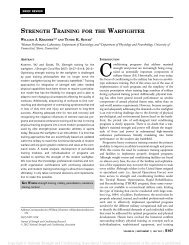
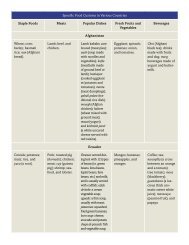
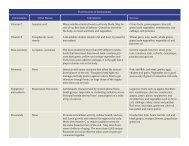
![Synthetic Drugs [PDF] - Human Performance Resource Center](https://img.yumpu.com/37447322/1/190x245/synthetic-drugs-pdf-human-performance-resource-center.jpg?quality=85)
